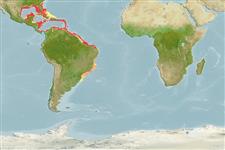Preferred temperature (Ref.
123201): 18 - 27.5, mean 24.7 °C (based on 218 cells).
Phylogenetic diversity index (Ref.
82804): PD
50 = 0.5000 [Uniqueness, from 0.5 = low to 2.0 = high].
Bayesian length-weight: a=0.01096 (0.00514 - 0.02340), b=3.05 (2.88 - 3.22), in cm total length, based on LWR estimates for this Genus-body shape (Ref.
93245).
Trophic level (Ref.
69278): 3.5 ±0.50 se; based on food items.
Widerstandsfähigkeit (Ref.
120179): mittel, Verdopplung der Population dauert 1,4 - 4,4 Jahre. (Preliminary K or Fecundity.).
Fishing Vulnerability (Ref.
59153): Low vulnerability (10 of 100).
Nutrients (Ref.
124155): Calcium = 36.7 [18.7, 91.8] mg/100g; Iron = 0.631 [0.319, 1.174] mg/100g; Protein = 18.9 [17.1, 20.6] %; Omega3 = 0.308 [0.168, 0.535] g/100g; Selenium = 20.2 [9.3, 40.3] μg/100g; VitaminA = 70.4 [21.7, 271.4] μg/100g; Zinc = 0.884 [0.561, 1.400] mg/100g (wet weight);
